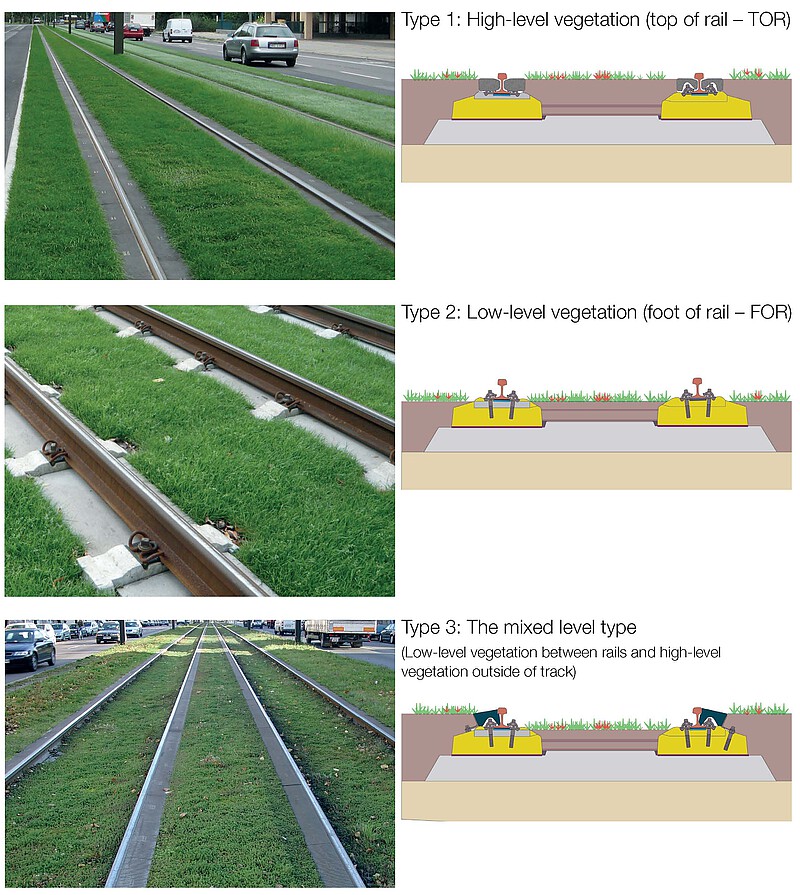Track greening
The types of track greening are differentiated according to the installation height of the vegetation systems in the track. In principle, the green track can be realised in three different design variants:
Selecting a type of Green Track system is determined by the following:
– the required track performance (insulation, care, maintenance)
– requirements associated with the vegetation system (site conditions, maintenance requirements)
– urban design requirements
Track with high vegetation
If the vegetation system is at a high level, the vegetation is installed on grooveless rails (Vignole rails) up to approx. 5 cm below the top edge of the rail. In the case of grooved rails, the vegetation can be installed up to approx. 1.5 cm below the top edge of the rail. This results in a visually uniform green area.
But as a result, the track is not as easily recognisable as a danger area. Recognisability improves when this solution is used in conjunction with rail chamber filling profiles. However, the rails and fastening systems are less accessible than with low vegetation, so exchanging them is more expensive. Above all, additional precautions need to be taken against stray currents. E.g., it is absolutely essential to isolate the rail from the humus and vegetation’s growth layer, since far greater leakage of current (greater conductance per unit length) is to be expected when there is direct contact.
Track with low vegetation
The vegetation system is installed up to the underside of the rail foot as maximum. The full height of the rails sits clear of the vegetation base layer, and plants/grass; and the rails remain clearly visible. Subject to design, Green Track systems with both grass vegetation and Sedum vegetation systems are feasible.
This has a number of operational advantages: the railway track (the area of both operation and danger) is clearly recognisable; the rails and rail fastenings are fully accessible at all times; inspection, repair and exchange work can be performed easily; there are no additional stray current problems; and the danger of the rail head becoming overgrown by vegetation (and thereby creating a danger of wheel slippage) is avoided.
However, in this solution a fully uniform green space is interrupted by the exposed stretches of rails.
Track with low vegetation between the rails and high vegetation outside
The vegetation system is installed as high-level vegetation system outside the rails and between tracks and as low-level vegetation system between the rails of each track. Thereby some transport companies compromise on both vegetation systems. The track is distinctively more visible compared to a high-level only vegetation system.
In addition, the rails and fastening elements in the inner track area can still be checked and are accessible. This is not the case on the outside of the rails, and here again the rail and soil have to be separated in an insulated manner to control the stray current problem.
Principles applying to green track
The basic rule to observe for all designs is this: The planting of greenery along tracks is always an additional feature when building a railway track; it has nothing to do with the track and superstructure’s actual support and guidance functions. Accordingly, its creation and maintenance normally also generate added costs. Consequently, for the transport companies the key basic demand for green track is that the normal function of the superstructure cannot be adversely affected by any added planting.
If this basic principle is observed, practically all design variants of green track are feasible. However, based on practical experience to date, the following preferences have emerged:
– If green track is used in conjunction with an open ballast superstructure with sleepers, in principle the planting should only be done at the earliest six months after the track has entered into use, and after the second packing operation. In addition, such tracks should be designed in such a way that they can be taken up again (e. g. installed using a humus or substrate layer on a reinforced geotextile).
– When new sections are built, green tracks are essentially better when used in conjunction with a slab track superstructure, since little or no follow-up work on the rail bed is anticipated for such solutions.
– The concrete of the slab track definitely has to be separated from the humus and/or substrate by a geotextile and/or foil (with drainage openings), and protected against long-term effects of moisture. In addition, the geotextile and/or foil is necessary to ensure a limited period of water storage.
– Where high vegetation systems are used, a secure, electrically insulating separation of the rail from the environment must be permanently guaranteed, to avoid corrosion and stray currents.
– The type of vegetation system used (grass, vegetation mats or another solution) definitely ought to be geared to the given route location and superstructure type, as well as to the framework conditions defined by these factors (e.g. lines running along inclines, precipitation, wind load, suction created by vehicles, and the available height of the growth layer). In addition, it should be remembered that continuous, low vegetation can only be achieved with a special substrate.
– All greenery systems require (more or less) aftercare and provision must be made for this in advance.
It is particularly important to ensure adequate coordination between the superstructure type and greenery system as early as the planning stage, and not add plants on a post-hoc basis (i. e. creating a less than optimal solution).
Recommended specialist book:
Grüngleisnetzwerk (Ed.), Handbook Track Greening
https://www.pmcmedia.com/en/all-titles/rail/162/handbook-track-greening

